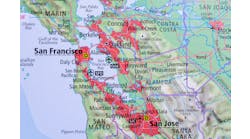Caring for Older Adults With Complex Needs During the Pandemic
The pandemic’s devastating impact on nursing home residents has put a spotlight on programs that care for patients with complex care needs in the community. “Never before have we so needed community-based, flexible alternatives to nursing home care for populations that have this level of need,” said Anne Tumlinson, a consultant focused on integrated care models for older adults.
One model that has stood out during the pandemic is called Program of All-Inclusive Care for the Elderly (PACE), an evidence-based model of care for older adults who meet a nursing-home level of care but mostly live in community settings. When the pandemic hit, these programs took innovative steps to shift many of their services from PACE day centers to home settings. One even transformed its day center into an infirmary for COVID-positive patients.
During a recent webinar coordinated by the Better Care Playbook and the National PACE Association, several PACE organization leaders described their experience of the pandemic. First, Chris van Reenen, Ph.D., vice president of regulatory affairs for the National PACE Association, noted that there are 263 PACE organizations in 31 states serving nearly 54,000 individuals. On average, each one works with about 400 enrollees. They are a high-cost, high-need population with significant impairments. On average, enrollees have six chronic conditions and 46 percent have dementia. Ninety percent are dually eligible for Medicare and Medicaid. Early research shows that approximately 4 percent of enrollees have been confirmed to be COVID-positive and 1 percent of enrollees have had COVID-related deaths.
PACE organizations receive capitated payments and are responsible for all services, including medical, behavioral, and long-term care services and support. Teams have flexibility in funding and can address social determinants or use funding to provide services such as installing an air conditioner for a person with respiratory illness. While all PACE participants must be certified to need nursing home care to enroll in PACE, only about 7 percent of PACE participants nationally reside in a nursing home. If a PACE enrollee needs nursing home care, the PACE program pays for it and continues to coordinate the enrollee's care.
Monitoring chronic conditions
Marianne Ratcliffe, M.H.A., executive director of the Piedmont Health SeniorCare in North Carolina; noted that because its enrollees are highly vulnerable to complications from COVID-19, they had to shift from its center-based program. “PACE traditionally has been high-touch and low-tech,” she said. “COVID forced us to turn that around. We moved from center-based services to home-based and some virtual services. We had to adjust our care management for those with chronic conditions. We all had to pivot very quickly.”
They did risk stratifications of their membership and identified new means of meeting their needs in care plans. They had to find different monitoring tools for those at high risk. In March Piedmont applied for a grant and purchased equipment to monitor them via devices such as blood pressure monitors and glucometers. They also converted a 12-passenger van into a mobile exam room. Every week every participant has a lengthy call from staff reviewing their health, nutrition and medications.
“One of the big things we have learned is the importance of connectivity,” Ratcliffe said. “Without that, depression and grief set in. Simple acts of kindness, unprompted, have helped sustain clinical outcomes and quality of life.”
Samantha Black, L.C.S.W., executive director of TRU PACE in Colorado, said her organization increased its focus on social determinant issues during the pandemic. She noted that 60 percent of its members live alone and 37 percent have cognitive impairment. “One hundred percent have poverty and economic hardship issues,” she said. Affordable housing is an issue. So is nutritional security. With a high percentage living at home alone during the pandemic they were suddenly very vulnerable about food. The other thing they realized was the importance of social relationships. “PACE organizations felt a mandate to figure out how we were going to support folks and mitigate social isolation,” Black said. “We need to get creative and find solutions to engage and help them feel connected. PACE is founded in a social model, to create a sense of community and inclusiveness. That is the foundation of everything we do.
To continue offering the warm touch that in-person day center visits have, TRU has deployed tablets and smartphones and social network platforms. They are holding weekly town halls with the idea of co-designing the experience with participants and staff. They also created a phone tree among participants to talk to each other and welcome new participants.
Transitioning day center to an infirmary
Summit ElderCare in Worcester, Mass., is the seventh-largest PACE organization in the country with six sites in Massachusetts and one in New York. It has 1,323 participants. The pandemic has tested PACE’s ability to adapt “in a way none of us could have imagined,” said Robert Schreiber, M.D., vice president and medical director. Although its day center sites remained open as the pandemic spread, only a small number of participants were attending. The organization decided to convert one of its PACE centers into an infirmary for COVID-positive members in need.
Getting the infirmary up and running was a huge undertaking. They had to delineate a vision and goals for an alternative care setting. Then they had to get approval from the state Executive Office of Health and Human Services and develop implementation and budget plans. Very quickly they were able to set up a 22-bed skilled care unit, after identifying staff, developing policies and procedures and obtaining PPE. They had to work through issues such as building code upgrades, food, medications, therapy, family visits and discharge planning. The first patient was admitted April 23 and 11 participants were served. Three passed away, but their families were able to be on site, Schreiber said. The last participant was discharged June 5.
Schreiber said this experience demonstrates that “PACE can uniquely transform to meet the needs of frail older adults in novel ways,” and that Innovations can give families hope and hospitals options. Now more than ever, PACE should be available to all eligible older adults.” The question, he said, is what does PACE look like moving forward?
An imperative for flexibility
Concluding the webinar, consultant Anne Tumlinson responded to the PACE organization presentations.
“The implications of what we have been able to observe PACE organizations doing during the pandemic with their care model, with their teams, with their resources, is that we have learned that provider-led risk models must be fostered going forward,” she said. “That includes PACE but is broader than PACE. States and the federal government have a mandate to think strategically about how to broaden the reach of PACE. And PACE organizations have to think more strategically about how they are going to broaden the portfolio of solutions they offer and the price points at which they offer them. They have to organize their services and interventions within different types of risk-based products that Medicare and Medicaid offer. For state and federal government policymakers, the notion that we have this money available to people for room and board only in a nursing home, that time is over.”
The imperative, she added, is for flexibility to deploy healthcare dollars differently. “We can’t do that through fee for service. There is nobody managing that pot of dollars and they are not flexible. We have to keep people at home, address engagement and reduce isolation and meet medical needs remotely. We are going to have to do that for a long time. That is going to be our mandate for the foreseeable future for this population. By definition, we have to be able to evaluate needs, access resources on their behalf, manage a complex array of services and coordinate it -- all of that can only be done in a really flexible platform like PACE.”


